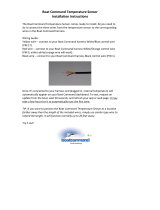
Mounting Considerations
NOTICE
If the device is mounted vertically, it is important to install it with
the connectors pointing downward. This will help avoid potential
water retention around the connectors.
This device should be mounted in a location that is not exposed
to extreme temperatures or conditions. The temperature range
for this device is listed in the product specifications. Extended
exposure to temperatures exceeding the specified temperature
range, in storage or operating conditions, may cause device
failure. Extreme-temperature-induced damage and related
consequences are not covered by the warranty.
• The device must be mounted in a location where it will not be
submerged.
• The device must be mounted in a location with adequate
ventilation where it will not be exposed to extreme
temperatures.
• It is best to mount the device horizontally, with the heat sink
facing upward.
• If the device must be mounted vertically, it must be installed
with the connectors pointing downward.
Mounting the Device
1
After you select a mounting location, determine the mounting
hardware needed for the surface.
Mounting hardware is included with the device, but it may not
be suitable for the mounting surface.
2
Place the device in the mounting location and mark the
location of the pilot holes.
3
Drill the appropriate pilot hole for one corner of the device.
4
Loosely fasten the device to the mounting surface with one
corner and examine the other three pilot-hole marks.
5
Mark new pilot-hole locations if necessary, and remove the
device from the mounting surface.
6
Drill the appropriate pilot holes for the other three marks.
7
Secure the device to the mounting location.
Card Reader Mounting Considerations
NOTICE
This device should be mounted in a location that is not exposed
to extreme temperatures or conditions. The temperature range
for this device is listed in the product specifications. Extended
exposure to temperatures exceeding the specified temperature
range, in storage or operating conditions, may cause device
failure. Extreme-temperature-induced damage and related
consequences are not covered by the warranty.
The card reader can be flush mounted in the dashboard using
the included hardware. When selecting a mounting location,
observe these considerations.
• The card reader should be mounted in an accessible
location. You must be able to access the card reader when
necessary to insert and remove memory cards containing
additional mapping and device updates, and to transfer user
data.
• To avoid interference with a magnetic compass, the device
should not be installed closer to a compass than the
compass-safe distance value listed in the product
specifications.
• The location must allow room for the routing and connection
of the cables.
Mounting the Card Reader
NOTICE
Be careful when cutting the hole to flush mount the device.
There is only a small amount of clearance between the case
and the mounting holes, and cutting the hole too large could
compromise the stability of the device after it is mounted.
If you are mounting the bracket on fiberglass with screws, it is
recommended to use a countersink bit to drill a clearance
counterbore through only the top gel-coat layer. This will help to
avoid any cracking in the gel-coat layer when the screws are
tightened.
The included template and hardware can be used to flush
mount the device at the selected location.
1
Trim the flush-mount template and make sure it fits in the
location where you want to mount the device.
2
Remove the protective liner from the back of the template
and adhere it to the location where you want to mount the
device.
3
Using a ¼ in. (6 mm) drill bit, drill one or more of the holes
inside the corners of the solid line on the template to prepare
the mounting surface for cutting.
4
Using a jigsaw, cut the mounting surface along the inside of
the solid line indicated on the template.
5
Place the device in the cutout to test the fit.
6
If necessary, use a file and sandpaper to refine the size of
the cutout.
7
After the device
À
fits correctly in the cutout, make sure that
the mounting holes on the device line up with the pilot holes
Á
on the template.
8
If the mounting holes on the device do not line up, mark the
new pilot-hole locations.
9
Using a center punch, indent the pilot holes and drill the
clearance counterbore through the gell-coat layer as advised
in the notice.
10
Remove the template from the mounting surface.
11
If you will not have access to the back of the device after you
mount it, connect all necessary cables to the device before
placing it into the cutout.
12
Place the device into the cutout.
13
Secure the device to the mounting surface using the included
screws
Â
.
14
Install the decorative bezel by snapping it in place around the
edges of the device.
3














